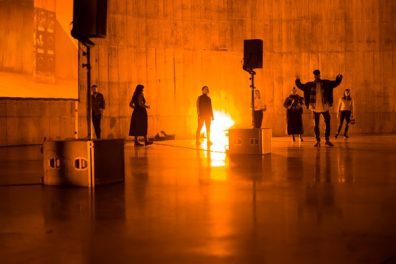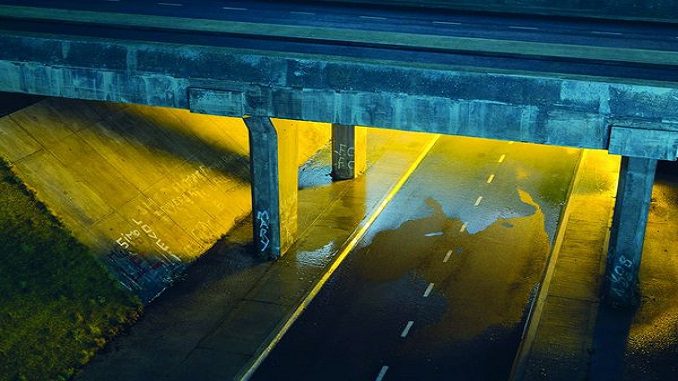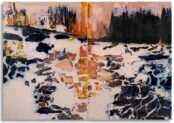[dropcap style=”font-size:100px; color:#992211;”]O'[/dropcap] Magic Power of Bleakness combines three works in the show by Mark Leckey, curated by Clarrie Wallis at Tate Britain. Leckey presents an immersive installation which utilises architectural scale sets, mesmeric visuals and trance-like audio to explore personal and societal themes.
‘Mark Leckey transforms Tate Britain’s galleries with a life-size replica of a motorway bridge on the M53 on the Wirral, Merseyside, where the artist grew up. The bridge – a recurring motif in his work – is the setting for a new audio play. Focusing on a group of teenagers, the play is inspired by folklore and stories of changelings and ‘fairy raids’ and by the artist’s own pre-adolescent experiences.’ Tate Britain

Extended Exorcism of the Bridge (2018)
O’ MAGIC POWER OF BLEAKNESS
The immediate effect of the installation is to subsume the viewer into the piece, the sound and scale of the work aid in the immersive effect, other people barely visible in the dark sitting on concrete benches become a part of the installation. A large section at the Tate Briton with a replica of a motorway bridge, recreated to resemble one where Leckey spent time as a youth defines the space. The viewer is invited to sit or stand under the liminal underpass and gaze at one of two large screens which project a phantasmagoria of imagery from three of Leckey’s video works; Under Under (2019); Dream English Kid, 1964-1999 AD (2015) and Fiorucci Made Me Hardcore (1999). To one side are smaller screens showing less clear close ups of the film which ads to sense of being surrounded by the sound and light show.

Mark Leckey recreates life-size motorway bridge in Tate Britain
A Troubled & Unknowable Land
These works cohere to describe a strange and otherworldly England; combinations of documentary footage inter-spliced with advertising and early computer graphics give the whole installation an ‘unheimlich’ or ‘uncanny’ atmosphere. Whereby familiar and nostalgic imagery is combined with with what seems alien and eerie.
‘Moving between homage and social critique, between personal and collective memory, between ecstasy and constraint, this cult work highlights the political complexities of class and youth in twentieth-century Britain’ Tate
Portents of Disaster?
There are repeated motifs which help to give a sense of order to the rhythmic onslaught of mesmeric imagery, these include: the bridge itself, a youth seen from behind looking over a motorway and the city beyond a Nike tick emblazoned on his back as he clutches a length of scaffold as if it were a banner, reminiscent of Roman solider surveying the land below.
There is skyline at dawn (or twilight) which almost breaks down into pixels and repeated images of a burning sun that reinforces the feeling of portent. The reference to modern and ancient is also emphasised by the repeated ritualistic and often manic dances and the two great pillars in the middle of the room which ‘resemble the standing stones of ancient sites’ (Claire Wallis, 2019).
The people on screen seem feral or possessed by an almost religious zeal; especially in their undulating and frenetic dance movements. This is a generous piece, the sound and visual stimulus work well to evoke a sense of time passing. References to 1980’s paranoia and genuine fear over a possible nuclear holocaust intermittently appear along with images of poverty and desolate space to give the work an edge beyond reference to personal memory and nostalgia. It is a trippy and hypnotising work at once dreamlike and nightmarish.

The aim of art is to represent not the outward appearance of things, but their inward significance. – Aristotle




















